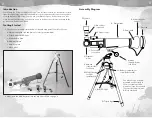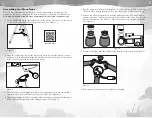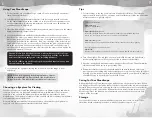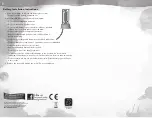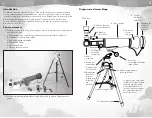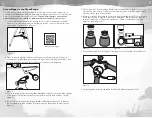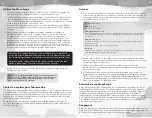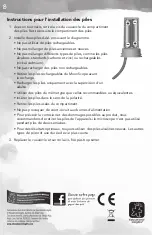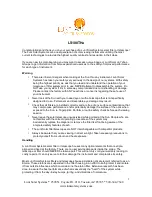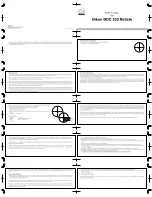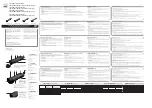
6
7
Using Your MoonScope
1. For best results, use your MoonScope outside. Don’t aim it through a window—
that will cause distortions.
2. Your MoonScope will perform much better if the lenses and air inside the tube
are the same temperature as the outside air, so let your MoonScope adjust to the
outside temperature. In extreme temperatures, it may take up to 30 minutes for
your MoonScope to adjust. Brrr!
3. Start viewing with your low power (20mm) eyepiece because it gives you the widest
angle and brightest, sharpest views.
4. Loosen the altitude and azimuth lock knobs and move the MoonScope in the
direction of an object you wish to view. Position your eye next to the eyepiece—
about three inches back from the finder scope. Look through the finder scope so
you see the crosshairs in the other end. (Can’t see the edge of the finder scope?
Shine a flashlight on it for a few seconds to illuminate the glow-in-the-dark ring!)
Move the MoonScope until your desired object is centered on the finder scope
crosshairs. Check that you can see the object through the eyepiece and tighten the
altitude and azimuth lock knobs.
5. Look through the eyepiece, turning the focus knob until the image is clear
and sharp.
Note: When looking through the diagonal mirror, objects
will appear right side up, but reversed, like a reflection in
a regular mirror. This is normal for astronomical telescopes.
Choosing an Eyepiece for Viewing
Your MoonScope comes with two different eyepieces—a 20mm eyepiece and a 4mm
eyepiece. Eyepieces are measured and labeled in mm (millimeters). The low-power
eyepiece is the one with the higher number in mm (20mm); it provides 18 times
magnification. The high-power eyepiece is the one with the lower number in mm (4mm);
it provides 90 times magnification.
As a rule, always start with the low-power eyepiece, then switch to the high-power
eyepiece only after you have located your desired object.
Caution: Never look directly at the sun, with or without your MoonScope.
Never aim your MoonScope at the sun, or anywhere near the sun. Instant
and irreversible eye damage can occur, including blindness.
Do not let children use the MoonScope without adult supervision any time
the sun is above the horizon.
Tips
1. To locate things in the sky, you must learn how the sky is laid out. The internet,
apps for mobile devices, books, sky maps, and local astronomy clubs can all provide
information about night sky objects.
2. Turn off any lights. (The red light on your tripod is OK because red light doesn’t
interfere with night vision.) Give your eyes time to adapt to the darkness.
3. Use slow, steady hand movements when using your MoonScope. This will minimize
vibrations and make it easier to get a steady view.
4. Remember that the rotation of the earth makes it appear as though objects are
moving across the viewing area and eventually out of view. You can lessen this effect
by using your low power lens. But after viewing for a while, you will need to readjust
your MoonScope to keep objects in your field of view.
Caring for Your MoonScope
After using the MoonScope, there may be condensation on the optical surfaces. When
you bring your MoonScope inside, take off the dust caps and let the moisture evaporate
naturally. (Leave the eyepiece on during this time so condensation can’t form inside the
optical tube.) Point the optical tube downward to keep dust from the air out of your
MoonScope. Once the moisture has evaporated, you can remove the eyepiece and
replace all the dust caps.
Storage
Store your MoonScope in its box with all dust caps and lens covers on. Accessories
should be stored separately in the box, with all of their dust caps on, too.
Three useful websites:
www.nasa.gov
NASA’s official website.
www.skyandtelescope.com
Astronomy website with useful information, including a customizable sky chart,
where you can type in your zip code for a map of the night sky.
www.astronomy.com
Website for an astronomy magazine with useful information about the night sky.
A useful app for your mobile device:
Star Walk
Allows you to hold up your mobile device and see what’s behind it in the night sky.


